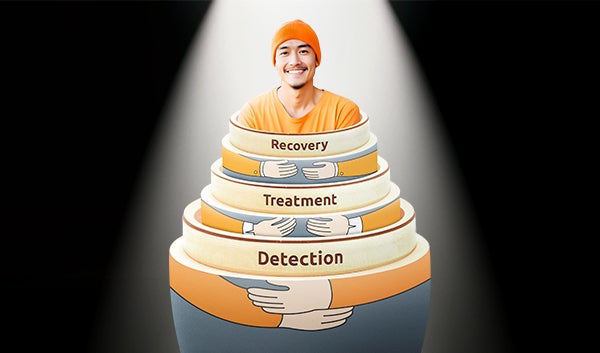Recognising and Tackling Stroke: Causes, Symptoms, Treatments and Recovery
Stroke is a leading cause of disability and the second leading cause of death globally, making early recognition and intervention crucial. In Singapore, stroke is also a major health concern. It is one of the leading causes of death and long-term disability, as stroke cases number around 8,000 to 9,000 annually, with 2021 seeing 9,680 cases. The rising number of strokes is concerning because this can have a significant impact on families.
This article aims to provide a comprehensive understanding of strokes, from the causes of stroke and symptoms to detailed treatment options and associated costs. We will also stress the importance of quick action at the first sign of a stroke and the crucial role of proper health coverage and financial planning in managing the expenses of treatment and recovery after a stroke.
What Causes a Stroke?
A stroke occurs when blood flow to a part of the brain is interrupted or reduced, preventing brain tissue from getting oxygen and nutrients. There are two main types of stroke:
Ischaemic Stroke
This is the most common type of stroke. It occurs when a blood clot obstructs or narrows an artery leading to the brain. This blockage prevents brain tissue from receiving adequate oxygen and nutrients, leading to the rapid death of brain cells. The primary risk factors for ischaemic stroke include:
- Hypertension (High Blood Pressure): Elevated blood pressure can damage arteries, creating conditions conducive to clot formation.
- Smoking: Smoking contributes to the acceleration of clot formation and atherosclerosis, which is the buildup of fatty deposits in arteries.
- Diabetes: Elevated blood sugar levels can damage blood vessels, increasing the likelihood of clot formation.
- High Cholesterol: Excessive cholesterol levels can result in plaque buildup within arteries, leading to their narrowing and an increased risk of blockage.
- Lifestyle Choices: Poor dietary habits, lack of physical activity, and excessive alcohol consumption contribute to the development of hypertension, diabetes, and high cholesterol, thereby increasing the risk of ischaemic stroke.
Haemorrhagic Stroke
This type of stroke occurs when a blood vessel in the brain ruptures, resulting in bleeding in or around the brain. This bleeding increases pressure on brain cells, causing significant damage. Haemorrhagic strokes are classified into two main types:
- Intracerebral Haemorrhage: This type occurs when an artery within the brain bursts, flooding the surrounding brain tissue with blood.
- Subarachnoid Haemorrhage: This type involves bleeding in the space between the brain and the thin tissues covering it.
The primary causes of haemorrhagic stroke include:
- High Blood Pressure: Chronic hypertension can weaken arterial walls, making them more susceptible to rupture.
- Aneurysms: Balloon-like bulges in arteries can stretch and burst, leading to brain bleeding.
- Trauma: Head injuries can cause blood vessels to rupture, resulting in haemorrhagic stroke.
- Arteriovenous Malformations (AVMs): These are tangles of abnormal blood vessels connecting arteries and veins, which can rupture and cause bleeding.
Aside from these, less common causes include arterial dissections or genetic disorders, emphasising the complexity and varied nature of stroke causes. In severe cases, strokes can lead to permanent neurological deficit, a condition classified as one of the 37 critical illnesses recognised by many insurance providers. It's important to note that temporary blockages in blood flow to the brain, known as transient ischemic attacks (TIAs), are not considered strokes but can be a warning sign of a future stroke.
Early Signs and Symptoms of Stroke
Strokes can range from very mild with barely noticeable symptoms to severe and life-threatening. The severity depends on the location and extent of brain tissue affected by the blood flow interruption. Recognising the early signs of a stroke can drastically improve outcomes. Therefore, remembering this F.A.S.T. acronym can be helpful for recognising stroke symptoms quickly, no matter if it happens to you or someone else:
- Face Drooping: One side of the face may droop or feel numb.
- Arm Weakness: One arm may feel weak or numb.
- Speech Difficulties: Speech may be slurred or hard to understand.
- Time to Call Emergency Services: This is the most important part. If you experience any of these symptoms, even if they go away quickly, call emergency services immediately.
Other stroke symptoms might include sudden confusion, trouble seeing, difficulty walking, or a severe headache. If you notice any of these signs, seek medical help immediately. This acronym also works for people who have encountered transient ischemic attacks. Acting quickly is crucial because strokes can lead to long-term effects such as paralysis, memory problems, and difficulty speaking.
Diagnostic Procedures for Stroke
Diagnosing a stroke involves several steps to determine the type and severity. The cost of diagnosing a stroke in Singapore can vary depending on the specific tests used, the healthcare facility, and the patient's insurance coverage.
Physical Exams
Healthcare professionals conduct thorough assessments of symptoms and review the patient's medical history. They might assess the patient’s muscle strength and coordination, balance and gait, sensory abilities (touch, vision, hearing), reflexes, and speech and language skills.
CT Scans
The healthcare professionals will use X-rays to create detailed cross-sectional images of the brain. CT scans can identify whether the stroke is ischemic or haemorrhagic and exclude stroke mimics such as brain tumours.
MRI Scans
MRIs use strong magnetic fields and radio waves to produce detailed images of the brain and surrounding tissues, which can visualise soft tissues and pinpoint blockages or damage more precisely than CT scans.
Neurological Assessments
Comprehensive tests to evaluate the nervous system's function and the impact of the stroke, which is essential for determining the appropriate treatment plan. These tests may include cognitive tests to assess memory, attention, and problem-solving abilities, as well as swallowing evaluation and vision tests.
Despite the potential costs of these assessments, early diagnosis is crucial for receiving the most effective treatment and improving recovery chances. The long-term financial burden of stroke treatment and potential complications can be much higher if diagnosis is delayed.
Treatment Options for Stroke
If a treatment is needed after confirming the patient’s condition, it varies depending on the type of stroke. The cost of stroke treatment also varies widely based on the type and severity of the stroke, the specific treatments required, and the duration of rehabilitation. For Ischaemic stroke, the treatment includes:
- Clot-busting Drugs (Thrombolysis): Medications like tissue plasminogen activator (tPA) can be administered intravenously to dissolve blood clots blocking blood flow to the brain. This treatment is most effective if given within a few hours of stroke onset, with a possible extension to 4.5 hours based on recent studies.
- Mechanical Thrombectomy: This is a procedure that involves inserting a catheter into an artery and using a specialised device to remove the clot directly. It is often used alongside clot-busting drugs or when medications are not an option to remove the clot using a catheter.
- Preventive Medication: After an ischemic stroke, healthcare professionals may prescribe anticoagulants (blood thinners) or antiplatelet drugs (aspirin) to help prevent future blood clots.
For haemorrhagic stroke, the treatment options include:
- Surgical Options: For haemorrhagic strokes caused by a burst blood vessel, surgery may be necessary to stop the bleeding and reduce pressure in the brain. Procedures such as aneurysm clipping or coiling are common surgical interventions.
- Other Interventions: Medications to manage blood pressure and reduce swelling in the brain are crucial parts of the treatment for haemorrhagic strokes. These measures help stabilise the patient and prevent further complications.
After any stroke, rehabilitation is a critical phase of long-term recovery, including physical therapy, occupational therapy, and speech therapy.
Understanding Treatment Costs for Stroke
Stroke treatment in Singapore can involve significant costs across various stages of care. Here's a breakdown of the estimated cost of treatment and rehabilitation after a stroke, as well as some major cost factors:
| Category | Estimated Cost (SGD) |
| Clot-busting Drugs (Thrombolysis) | $5,000 - $10,000 |
| Mechanical Thrombectomy | $20,000 - $30,000 |
| Surgical Treatments | $30,000 - $50,000 |
| Rehabilitation | $3,000 - $10,000 per month |
Note: These costs can vary widely depending on the healthcare system, insurance coverage, and location. The costs can be lower in public hospitals compared to private hospitals
- Emergency Care: This includes immediate medical attention and hospitalisation upon experiencing a stroke.
- Surgical Procedures: The cost of surgery varies depending on the type and complexity required. Generally, it can be higher than other treatment options.
- Long-term Rehabilitation: Rehab after a stroke is an ongoing process that can last for months or even years. The estimated cost reflects a monthly range for therapy and support services.
Financing Stroke Treatment
Given the potentially high costs of stroke treatment and rehab after stroke, financial planning for potential health crises is essential. Having health insurance to cover the costs on top of MediShield coverage can be helpful, along with long-term disability insurance that can provide a safety net if long-term effects arise.
To provide more protection for yourself or your loved ones, consider Income’s Complete Critical Protect as it provides comprehensive coverage for dread diseases, from early to advanced stage dread disease, as long as they are insured before your diagnosis and after their respective waiting periods. Here’s how it can help you:
- Coverage against recurrent conditions1,2 like persistent major cancer, recurrent heart attack and recurrent stroke with the Protect Max option.
- Receive protection for 3 organs vital for survival - heart, lungs and kidneys under Vital Function Benefit3,4,5.
By securing the right coverage, you and your family can better navigate the challenges of stroke recovery.
Living Beyond Stroke: A Look at Recovery After Stroke and a Hopeful Future
No one wants to imagine the possibility of a stroke, but by being prepared, you can significantly reduce the stress and burden associated with treatment and recovery. This includes prioritising early detection through regular health screenings. These screenings can identify risk factors like high blood pressure and cholesterol, allowing for early intervention and lifestyle changes that can significantly decrease the stroke risk for you or your loved ones.
While recognising and tackling stroke is crucial, there's also hope for a fulfilling life beyond it. Early intervention and proper medical care can improve outcomes, and empower you or your loved ones on their road to recovery from stroke.
1 If the policyholder has chosen Protect Max, the total Income Insurance will pay under the following benefits:
- Dread Disease Benefit;
- Recurrent Benefit; and
- Vital Function Benefit,
are aggregated and will not be more than 1000% of the sum assured, less any amount the policyholder owes Income Insurance.
If the insured is also covered by Dread Disease Benefit, Recurrent Benefit and Vital Function Benefit (or equivalent benefits) under any policies which have been issued and paid (whether issued and paid by Income Insurance or by any other insurer), the total of these benefits under all these policies cannot be more than $3.6 million (including premiums waived due to dread disease but excluding bonuses). In this case, Income Insurance will first take into account the amounts due under the earlier policies and then pay out only an amount to bring the total payments to $3.6 million (including premiums waived due to dread disease but excluding bonuses).
2 The Recurrent Benefit is only applicable if the policyholder has chosen Protect Max. Income Insurance will pay the Recurrent Benefit, less any amount the policyholder owes Income Insurance, as long as the following conditions are met:
- Recurrent Benefit has not ceased at the time of any payment of the benefit;
- the insured survives at least 7 days after the date of diagnosis or date of surgery performed for a dread disease covered under this benefit, whichever is later;
- if more than one dread disease covered under the Dread Disease Benefit and/or recurrent condition and/or impairments of vital function are diagnosed on the same date, Income Insurance will only approve one claim with the highest possible benefit payout regardless of the number of dread diseases and/or recurrent condition and/or impairments of the vital functions that are diagnosed; and
- maximum of 3 claims may be approved under this benefit.
This benefit will end once:
- 300% of the sum assured has been fully paid out under this benefit; or
- the total amount Income Insurance has paid under Dread Disease Benefit, Recurrent Benefit and Vital Function Benefit reaches 1000% of the sum assured,
whichever is earlier.
Income Insurance will not pay this benefit:
- if your claim arises from any recurrent condition covered under this benefit occurring within 24 months from the date of diagnosis or date of surgery performed, whichever is later, of the latest claim approved under the Dread Disease Benefit, Recurrent Benefit or Vital Function Benefit; or
- if the insured was diagnosed with persistent major cancer, recurrent heart attack of specified severity or repeated coronary artery by-pass surgery within 90 days from the cover start date. For repeated coronary artery by-pass surgery, the date of diagnosis will be the date the medical condition that leads to the surgery is diagnosed, and not the date of the surgery.
The policy will continue even if this benefit ends.
3 If the policyholder has chosen Protect Max, the total Income Insurance will pay under the following benefits:
- Dread Disease Benefit;
- Recurrent Benefit; and
- Vital Function Benefit,
are aggregated and will not be more than 1000% of the sum assured, less any amount the policyholder owes Income Insurance.
If the insured is also covered by Dread Disease Benefit, Recurrent Benefit and Vital Function Benefit (or equivalent benefits) under any policies which have been issued and paid (whether issued and paid by Income Insurance or by any other insurer), the total of these benefits under all these policies cannot be more than $3.6 million (including premiums waived due to dread disease but excluding bonuses). In this case, Income Insurance will first take into account the amounts due under the earlier policies and then pay out only an amount to bring the total payments to $3.6 million (including premiums waived due to dread disease but excluding bonuses).
4 If the policyholder has chosen Protect 100, the total Income Insurance will pay under the following benefits:
- Dread Disease Benefit; and
- Vital Function Benefit,
are aggregated and will not be more than 100% of the sum assured, less any amount the policyholder owes Income Insurance.
If the insured is also covered by Dread Disease Benefit, Recurrent Benefit and Vital Function Benefit (or equivalent benefits) under any policies which have been issued and paid (whether issued and paid by Income Insurance or by any other insurer), the total of these benefits under all these policies cannot be more than $3.6 million (including premiums waived due to dread disease but excluding bonuses). In this case, Income Insurance will first take into account the amounts due under the earlier policies and then pay out only an amount to bring the total payments to $3.6 million (including premiums waived due to dread disease but excluding bonuses).
5 Income Insurance will pay the Vital Function Benefit, less any amount the policyholder owes Income Insurance, subject to the following:
- Vital Function Benefit has not ceased at the time of any payment of the benefit;
- no claim has been approved for advanced stage dread disease;
- the insured survives at least 7 days after the date of diagnosis on a vital function covered under this benefit; and
- if more than one dread disease covered under the Dread Disease Benefit and/or recurrent condition and/or impairments of vital function are diagnosed on the same date, Income Insurance will only approve one claim with the highest possible benefit payout regardless of the number of dread diseases and/or recurrent condition and/or impairments of the vital functions that are diagnosed.
If the policyholder has chosen Protect 100, Income Insurance will pay the Vital Function Benefit less claim paid for early stage and/or intermediate stage dread disease under Dread Disease Benefit. This benefit will end once:
- a claim has been paid out under this benefit; or
- the total amount Income Insurance has paid under Dread Disease Benefit and Vital Function Benefit reaches 100% of the sum assured,
whichever is earlier.
If the policyholder has chosen Protect Max, Income Insurance will pay the Vital Function Benefit less claim paid for early stage and/or intermediate stage dread disease of the corresponding dread disease under Dread Disease Benefit. This benefit will end once:
- a claim has been paid out under this benefit; or
- the total amount Income Insurance has paid under Dread Disease Benefit, Recurrent Benefit and Vital Function Benefit reaches 1000% of the sum assured,
whichever is earlier.
Income Insurance will not pay this benefit:
- if your claim arises within 12 months from the:
- date of diagnosis of early and/or intermediate stage dread disease of the latest claim approved under early and/or intermediate stage dread disease outside of the corresponding dread disease; or
- date of surgery performed under early and/or intermediate stage dread disease of the latest claim approved under early and/or intermediate stage dread disease outside of the corresponding dread disease,
whichever is later; or
- if the insured is diagnosed with any impairment of a vital function covered under this benefit any time before or within 90 days from the cover start date.
The policy will continue even if this benefit ends.
This article is meant purely for informational purposes and does not constitute an offer, recommendation, solicitation or advise to buy or sell any product(s). It should not be relied upon as financial advice. The precise terms, conditions and exclusions of any Income Insurance products mentioned are specified in their respective policy contracts. Please seek independent financial advice before making any decision.
These policies are protected under the Policy Owners’ Protection Scheme which is administered by the Singapore Deposit Insurance Corporation (SDIC). Coverage for your policy is automatic and no further action is required from you. For more information on the types of benefits that are covered under the scheme as well as the limits of coverage, where applicable, please contact Income Insurance or visit the GIA/LIA or SDIC websites (www.gia.org.sg or www.lia.org.sg or www.sdic.org.sg).
This advertisement has not been reviewed by the Monetary Authority of Singapore.








